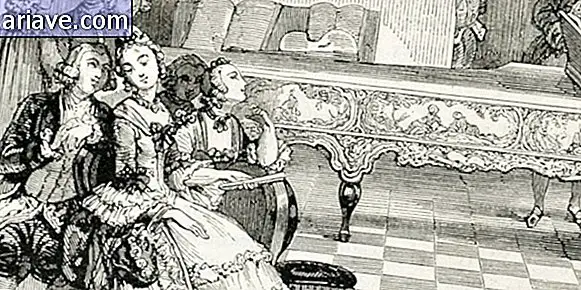Learn 7 Amazing Deck Trivia
From the junk wheels with friends to the fortune teller's tables to the solitaire game that saved many lives from boredom before the internet, the deck is there, making history, bringing people together, creating rivalries and friendships. Here are some curiosities about playing cards:
1 - Not every card game is a deck of cards.

It sounds confusing, but it's actually quite simple. By definition, deck is that set of cards with numbers, followed by the jack, queen and king, and distinguished by four different suits, two black and two red. This is why cards from other games, such as Mico's, for example, with different images, are not called cards. At least not theoretically ...
2 - The invention of the deck

You may have heard that board games are ancient and even quite popular in the time of the Roman Empire and Ancient Egypt. That is why, by comparison, the deck is a relatively new invention.
The earliest historical records of this type of game are from the thirteenth and fourteenth centuries, and unlike the boards, with the deck players do not have a complete view of what is happening in the round. The deck therefore brought the feeling of mystery along with each play. Is it because of the mystery that fortune tellers use cards to predict the future?
The popularity of deck games has a lot to do with the sheer amount of games available - card, lock, hole, patience, hearts, poker and so on - as well as ease of transport.
3 - In China

The first record of a card-related incident was in 1294, in China, when Emperor Kublai Khan tried two Chinese who had been caught for gambling. Not only did they play, but they also made decks, which aggravated the accusation; after all, playing cards was banned for a long, long time.
Chinese cards, which served and still serve as models for today's decks, were much smaller than ours, with the rectangle of each card being 10 cm by 2.5 cm.
4 - In other parts of the world

Korean deck records date back to the nineteenth century and, physically speaking, are completely different from the ones we know - and even look nothing like the Chinese deck.
In Europe, the deck was known since the fourteenth century. It is not known how the continent knew about "gambling" and in this sense there is a lot of cross-information: while some historians believe that Gypsies brought tradition to the continent, some believe that the deck was brought by Marco Polo or other discoverers. . Some scholars believe that the deck was created by the French king Charles VI in 1392 - detail: by that time the deck was already common in Europe.
In India, the cards are different and round. Moreover, in the land of the Taj Mahal there is the 120 card deck with 10 different suits! It is estimated that Indians began to enjoy card games only in the 16th century.
Japan knew the deck thanks to the Portuguese, who came to the country with the news in the seventeenth century.
5 - What about the tarot?

The tarot cards were created in Europe, and the earliest records are from the city of Ferrara, Italy, in 1442. The oldest tarot deck produced in Milan is believed to be from 1441. The tarot has 22 more cards than the standard deck, and color images have been added to each card.
In the beginning, games played with tarot cards were called trionfi cards, making it clear that the goal of the game was to win, to triumph. Over the years the games were improving and the name tarot, which may have its origin in French, as some historians believe, began to be used.
The truth is that the tarot was born in Italy as another game, with some extra cards. It then became popular in Switzerland, southern France, Germany and Austria. In English and Spanish speaking countries the tarot has only been known for its mystical interpretation. It is believed that if England and Spain knew about the game of tarot, it could be as popular as poker today.
Over the years the designs used on each card have been modified according to the culture of each region. In Austria, tarot decks are quite different: the illustrations refer to the region's rural activities between the 18th and 19th centuries.

The first time the 32-card deck was seen as a means of predicting the future was in 1770, when Jean-Baptiste Alliette published a book that taught how to interpret each card. The tarot, however, was not yet known in Paris.
The tarot itself was introduced by Protestant pastor Antoine Court de Gébelin, who published nine books on the subject between 1773 and 1782. He even talks about the symbolic interpretation of the deck's images, but does not even talk about predictions of the future. Still, it was thanks to Gébelin's publications that Alliette, who changed her name to Etteilla, began to make predictions.
Etteilla was considered the great fortune teller of his time. With a knack for business, his esoteric interpretations became increasingly popular.

The practice of divination through tarot cards or the traditional deck of cards was forgotten for a few years and lost its relation to the occult in the nineteenth century, when another Frenchman, Alphonse-Louis Constant, popularly known as Éliphas Lévi, decided to reactivate the practice and, including the occult of deck predictions. It is thanks to this guy that even today it is possible to find tarologists and fortune tellers.
Countries that did not know tarot as a game, such as England, Spain, the US and even Brazil, only know this deck by the mystical side that it presents. In countries that have known the game itself, talking about tarot is like talking about truco. It has no hidden meanings.
6 - Other uses

In 1793, during the French Revolution, there was little paper money and, to solve the problem, playing cards were used to print new banknotes. Something similar happened in Canada and Suriname.
When the card stock used to make the deck was difficult to access, the ready-made decks were used in book binding and business cards!
Playing cards were also used to identify children left in orphanages in the early nineteenth century. It was common for mothers to think about retrieving their children, so they left one piece of a letter attached to their baby's clothes - the other piece was with the mother. When they were better off financially and socially, they returned to the orphanages with the letter, hoping to find their children again.
7 - Warnings

If cigarette packaging today warns that smoking is dangerous, perhaps the inspiration for this type of warning came from a case in 1796, when a city in northern Switzerland filed a complaint against a group of farmers. who played Jass for a whole night.
The rebuke they suffered was great, and from that moment on, the City Council recommended that local residents avoid abusing the games. A local manufacturer started printing playing cards with the phrase “Ad usum, non abusum”, which means “to use without abuse”.
***
So, did you already know all this about it? If you have a nice story involving some kind of gambling, tell us in the comments!











